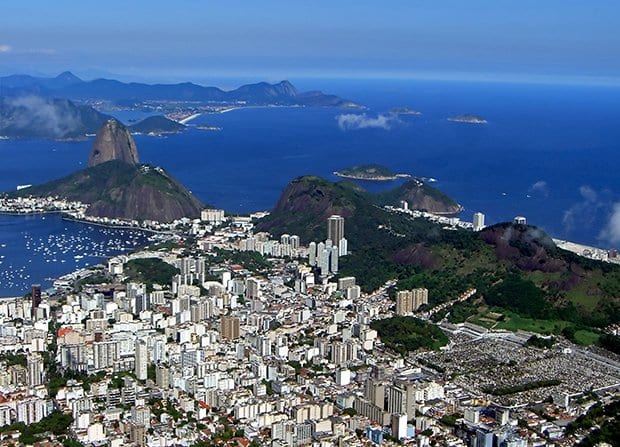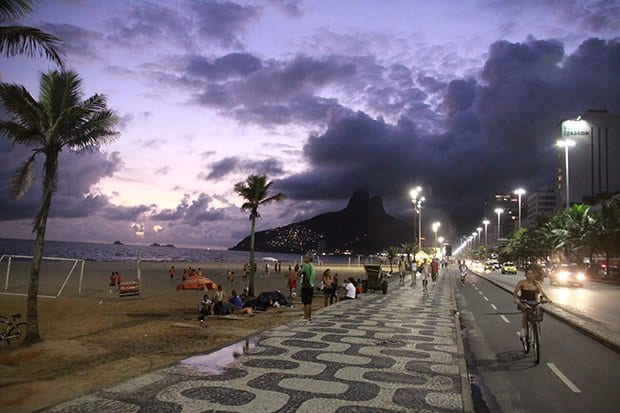
Rio de Janeiro from the Corcovado. Credit: Ramon

Young men celebrating during a Carnival street parade in Copacabana. Credit: Michael Luongo

Sunset over Ipanema Beach. Credit: Michael Luongo

Ulisses Rabelo with a Carmen Miranda mannequin he created for the Carmen Miranda Museum. Credit: Michael Luongo

Men on the beach playing volleyball in Rio de Janeiro. Credit: Michael Luongo
To my mind, there is no more beautifully situated city in the world than Rio de Janeiro. A beachside metropolis, my favourite kind of urban destination, it spreads up from the Atlantic Ocean into the dramatic mountains behind it. Many are oddly rounded in shape, like Sugarloaf (which takes its name from a time when sugar was shaped in cones) and Corcovado (“hunchback” in Portuguese), graced for more than 80 years by the outstretched arms of Christ the Redeemer, who blesses the city and her residents no matter what sins they get up to.
Rio dates back to the 1500s and was once the capital of Brazil, before the central government was moved in the middle of the last century to Brasília, in the wilds at the heart of the country. Still, even the designers of the new capital so loved Rio they refused to live in Brasília. The most famous architect of the new capital, Oscar Niemeyer, lives in a curvaceous ocean-view high rise on Avenida Atlantica. Niemeyer, who is more than 100 years old, is the perfect example of what locals call a Carioca de Gema, or native of Rio “down to the yolk.” Such people refuse to leave Rio; once you visit this seductive city with its mix of danger, sensuality and beauty, you’ll understand.
My first visit to Rio was in 2000, and I landed in the middle of Carnival. I was travelling with my friend Jim Green, a professor at Brown University and the author of the book Beyond Carnival, about Brazil’s gay history. I could not have had a better person as a guide.
We spent time in Copacabana, where the gay beach, marked by its own rainbow flag, sprawls from the famous Copacabana Palace hotel. We delighted in watching famous Brazilian pornstars order drinks from the gay kiosk on Avenida Atlantica, with its black and white swirled walkways.
The other gay beach is in Ipanema, a more upscale, less crowded part of the city where we watched well-toned men (often called Barbies for their beautiful, though distinctly male, physiques) play volleyball where the sands meet the Rua Farme de Amoedo, considered the main gay drag. I partied at the Banda de Ipanema street festival while getting rained on, surrounded by hundreds of Speedo-clad men whose feathery headdresses wilted to the pavement.
Farther from the centre of Rio is the beach at Leblon, and during Carnival it’s home to the Gay Ball at the social club Scala, which for me was the highlight. I danced with a hunky Argentine tourist, a transgender beauty and a ball-gowned woman old enough to be my grandmother. All this special gay fun was in addition to the normal goings-on during Carnival, including the Sambadromo, where the parades of samba schools competing for the best themes and costumes all take place.
Carnival, which takes place just before Lent, is the party that put Rio on the map, but there are other great times to visit the city. One of the world’s biggest New Year’s celebrations is Réveillon, when millions of Cariocas dress in white and head to the beach, throwing flowers into the Atlantic Ocean as offerings to Yemanja, the goddess of the sea, celebrated in the Penelope Cruz movie Woman on Top. We all know what happens when white clothes hit water, so after the flowers are thrown, people find other ways to ring in the new year.
Any event will have a gay dimension in Rio, but if you want to visit during Pride itself, head to Rio in October, just as summer is beginning. This year’s Pride had nearly a million participants. Clovis Casimiro, the commercial director of the gay tourism promotion group ABRAT GLS, says that during Pride or any time, “Rio is so fun because of the local people and the combination of nature and metropolis — and also because Rio means the Brazilian way of life — relaxed, happy, colourful, with music and great hosts!”
Casimiro reminds us that while beaches made Rio famous, the city is so much more than just that. Within the old downtown, you’ll find fantastic colonial churches, like São Bento, with its interior awash in gold, or the space-capsule-shaped Catedral Metropolitana. I love the old plazas here in the centre, often devoid of tourists, who stick to the beaches. The downtown is full of imposing early-20th-century classical structures, along with mid-century moderns built under dictatorships, which seem almost Pharaonic in scale.
No gay person worth his or her salt will want to miss the neighbourhood of Flamengo, with its Carmen Miranda Museum. Gay artist Ulisses Rabelo sculpted many of the mannequins that hold the brilliant clothes this Brazilian star wore in numerous Hollywood musicals of the 1940s.
Overlooking Rio is the hillside neighbourhood of Santa Teresa, which has undergone a revival and is full of artists and galleries. At the bottom of the hills, below Santa Teresa, is a famous aqueduct, the Arcos da Lapa, in the area known as Lapa. This neighbourhood, now full of clubs and music bars, is a little seedy and was once the haunt of the legendary Madame Satã, whose real name was João Francisco dos Santos, an infamous gang member and drag performer in the 1920s and 1930s.
Madame Satã is just one example of Rio’s gay history and her always-lurking dangers. The city has dramatically improved in the past decade in both cleanliness and safety, as all of Brazil’s economy has uplifted and with the city preparing for the Olympics. Still, night is a time to be cautious. I was once attacked by young kids with knives in Copacabana. In the end, I was relatively unharmed, just a little shaken, but I was left with one of my favourite Rio stories. I flagged down the police, explaining to them what had happened, but we could not find the suspects when we did a drive-around. The police asked me where I was heading, which was to a new gay bar (since closed.) The policemen did not know of it but said they would instead take me to Le Boy, Rio’s best-known gay club. They turned on the sirens and the flashing lights and sped me through the streets. In front of Le Boy, I hugged and kissed the policemen goodbye and stepped out of the patrol car into the club, skipping the long line, with everyone thinking I was a celebrity or a gay cop.
There is no city in the world quite like Rio.
Getting there
You’ll most likely fly into Galeão International Airport, about 45 minutes northwest of the city. Santos Dumont Airport, closer to the city, is where the Rio–São Paulo air shuttle touches down. Pay-in-advance airport taxis can be found at both of these gateways.
Getting around
Rio’s Metro is an excellent subway and rapid transit system. Tourists can connect between Ipanema, Copacabana, Botafogo, Flamengo, Glória, Central Station in downtown, and beyond, then hop a taxi for streets around the stations. Buses are everywhere, but unless you’re a local you probably won’t figure them out before it’s time to board your homeward-bound flight. Taxis are easy to hail on the street, but if you want an air-conditioned cab, you might have to have your hotel call one for you. They are more expensive but worth it on the hottest days.
Neighbourhoods
Ipanema and Copacabana are the centre of Rio de Janeiro’s gay nightlife. Nights out for locals usually begin at friends’ houses, in cocktail lounges or over dinner before they hit the dance clubs after midnight. Though Ipanema has no big dance clubs, it has plenty of small and chic clubs. Watch out for circuit parties, too. They might be anywhere — from the beach to an old industrial building or on a farm outside the city — but most take place in the downtown district.
Currency
The Brazillian real (meaning “royal”) is the local currency. The coins are divided into the same denominations as most currencies, so getting to know the local money is easy. Online websites like XE provide exchange rates that are close to what credit or debit card scales will be. Plastic is widely accepted, so you won’t need to risk carrying a lot of cash. As always when going abroad, inform your bank of your travel plans (to avoid anti-theft protocols), find out if they have local partner banks (to save on ATM charges), and get phone numbers other than 800 codes — which sometimes won’t work outside the US and Canada — just in case.

 Why you can trust Xtra
Why you can trust Xtra